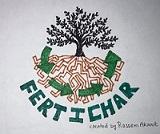FERTICHAR will use an innovative case-study approach that offers the best conditions work and exchanges to scientists and locally relevant actors concerned by olive mill wastes fate and agricultural production systems, under various pedoclimatic conditions and socioeconomic settings in Europe and North Africa. The adopted methodology will consist firstly on the impregnation of OSW by OMW and then its thermal treatment by two procedures, i.e., slow pyrolysis and thermal carbonization in order to produce nutrients-enriched biochars/hydrochars, respectively. Then, these two kinds of derived-solid residues will be used as amendments for olive trees (field assays) and high added economical values crops (tomatoes in lab experiments). Their positive effects on these plants growth, nutrients release, carbon sequestration and organic pollutants retention will be experimentally and numerically assessed in both Europe and North Africa. For maximizing the project socio-economic impacts, the main concerned stakeholders will be implicated from the beginning of the project. Exchange of researchers and students will be the core activities for innovation transfer. Specific tools and actions (website, social media channels, conferences...) will be used for the exploitation, dissemination and communication of the main project outputs to stakeholders and scientists.
Work Packages and Tasks
WP1 Project management and quality assurance
- Task 1.1: Overall project management, legal and ethics aspects ( Lead /participants: IS2M, all partners) (M1–M36)
- Task 1.2: Scientific management, quality control and risk management( Lead/participants: IS2M, all partners) (M1 – M36)
- Task 1.3: Organization and participation of common kick - off, bi - annual, and final meeting and annual project coordination meetings ( Lead /participants: IS2M , all partners) (M1 – M36)
WP2 Stocks identification and characterization of olive
- Task 2.1 Assessment of the olive cultivated lands (Lead/participants: UB, all partners) (M1 – M4)
- Task 2.2 Stocks identification and characterization of the olive mill produced wastes (Lead/participants: UB, all partners) (M1 – M6)
- Task 2.3 Assessment of the used management techniques of olive mill solid wastes (OSW) and olive mill wastewaters (OMW) (Lead/participants: UB, all partners) (M1 – M6)
WP3 Biochars and hydrochars synthesis from OSW and OMW andBiochars and hydrochars synthesis from OSW and OMW andphysico-chemical characterization
- Task 3.1. Optimization of biochar and hydrochar production at lab scale (Lead/participants: IS2M, CERTE) (M1 – M18)
- Task 3.2. Biochars and Hydrochars Characterization (Lead/participants: IS2M, CERTE, BU) (M1 – M18)
- Task 3.3. Biochars and Hydrochars Production at large scale (Lead/participants: IS2M, CERTE, RITTMO) (M1 – M18)
WP4 Agronomic valorization of the synthesized chars
- Task 4.1. Nutrients release dynamics from the used chars under different laboratory scales(Lead/participants: RITTMO, CERTE, HAO) (M6–M24)
- Task 4.2. Mycorrhized chars development (Lead/participants: RITTMO,CERTE, HAO) (M12–16)
- Task 4.3. Chars application in field experiment (Lead/participants: RITTMO,CERTE,HAO) (M16–36)
WP5 Environmental valorization of the synthesized chars
- Task 5.1. Evaluation of pesticides retention by the produced chars in batch mode(Lead/participants:, CERTE, IS2M, HAO) (M12 – M18)
- Task 5.2. Evaluation of pesticides retention by the produced chars in column mode(Lead/participants: CERTE, HAO) (M12 – M24)
- Task 5.3. Evaluation of pesticides bioavailability in chars amended soils in laboratory pot mode(Lead/participants: CERTE, HAO) (M12 – M36)
WP6 Modeling of water flow and geochemical processes in agricultural soil environment
- Task 6.1. Numerical modeling of chars agricultural valorization assays
- Task 6.2. Numerical modeling of chars environmental assays
- Task 6.3. Long term biochars application simulations
WP7 Exploitation, Communication and dissemination
- Task 7.1. Development of Exploitation, communication and dissemination plans
- Task 7.2. Web site development and social media dissemination
- Task 7.3. Communications with stakeholders, scientific community other projects and initiatives

